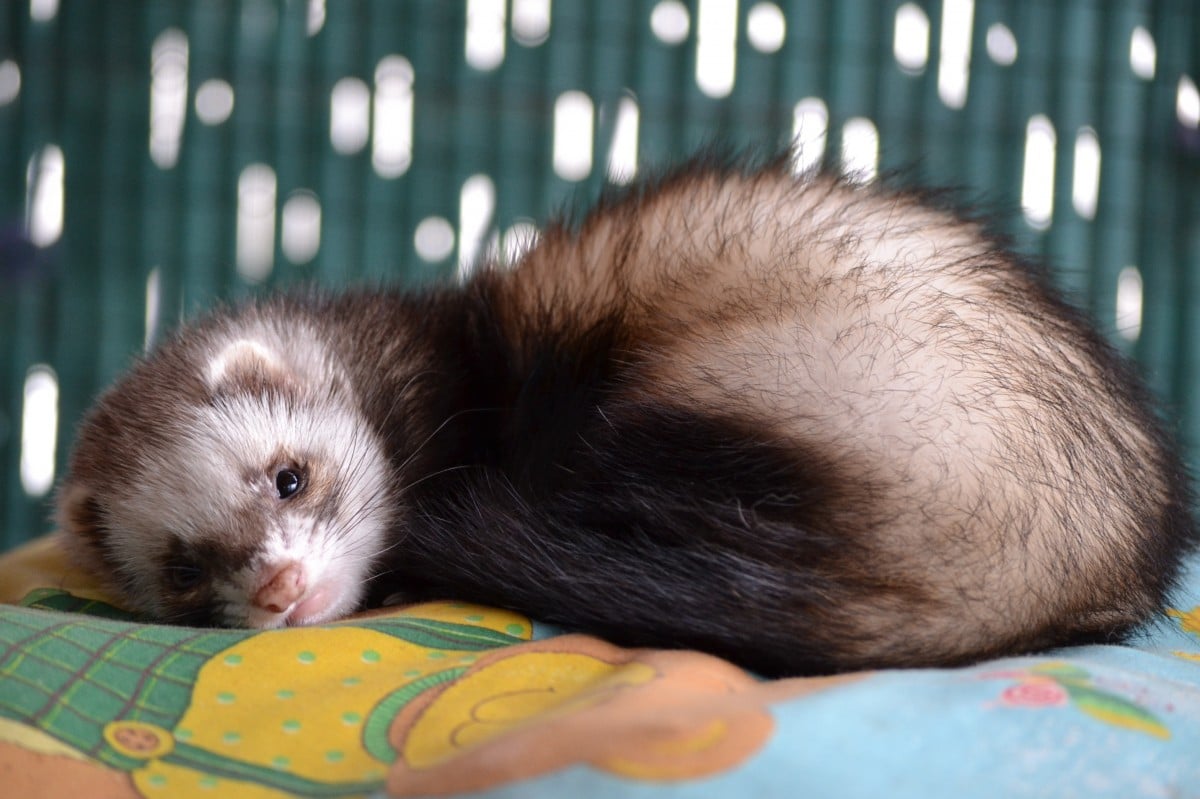Winnebago County Animal Services adopts Ferrets to be family pets. Under no circumstances should a Ferret be used for food for other animals; for experimentation or laboratory work; or for any other use other than as a family pet. WCAS strictly enforces this policy under the terms of the adoption contract.
Choosing Your Ferret
The ferret makes a very loving and playful pet. The ferret is often described by their owners as “kittens who never grow up.” You might be asking yourself if you should adopt one ferret or more. Ferrets don’t need another ferret to be happy, but if you are gone a lot, two or more will keep each other company. They’ll be more fun, but also require more responsibility. Some people recommend getting one at first, so you and the animal can get acquainted. There is some advantage to only training one at a time. If you decide later you want more, there’s no problem mixing (neutered) ferrets of either gender. Each ferret has a personality of his or her own.
The young ferret is called a Kit. There are contradictory opinions regarding the best age to obtain a ferret for a new owner. Adults tend to be a bit calmer and may already be litter trained. Kits are very cute, playful and would require a little more care and training. The life span of a ferret is 6-8 years
Selecting a Cage
If you are gone from home a good portion of the day and plan to have your ferret in a cage, a generous-size cage is advisable; about 2’x3’. This size will allow a second or third ferret to share the cage. Many people use aquarium tanks as a ferret home. Tanks may be easier to clean, but they don’t provide much ventilation at the bottom. Plain wood cages aren’t recommended because the wood soaks up urine and other fluids. Multiple level cages are probably the most popular ferret home. Large size plastic dog kennels work well and also make it easy to take your ferret with you.
In the cage set up a “bedroom” for your pet. A ferret is not happy sleeping on the open floor of their cage. Any box or basket works well as a bedroom. Old towels make excellent bedding as long as they aren’t too easily chewed to bits. Loose strings or edges should be trimmed. Towels or sheets should be placed at the bottom of the cage. A small litter box filled with a small animal litter should also be provided at the bottom of the cage. Even if you allow your ferret to have the run of the house, they need a safe place to call home when they aren’t supervised.
Food and Water Containers
Ferrets like to dig in their food or water bowls. The best solution is to provide a water bottle and ignore the digging. You can put their food dish in a larger container. Bowls that angle inward can help; some people like a “J” type rabbit feeder. Heavy ceramic dishes help prevent them from tipping them over.
Training Your Ferret
If your ferret’s favorite corner to relieve themselves isn’t your favorite, put a crumbled towel or food bowl in that corner making it look more like a bedroom than a latrine. Ferrets don’t like to mess up their sleeping quarters. Accidents do happen and these corners should be cleaned with bleach or another bad-smelling disinfectant (don’t let your ferret back into this area until it dries). Even well trained ferrets lose track of their litter plans when they are frightened or excited.
Finally, if your pet has forgotten completely about its litter pan, confine it to a smaller area in a cage for perhaps a week, gradually expanding his space as he catches on.
Health Care
Ferrets’ toenails will need trimming. Cut the nail just longer than the inside pine line. Be careful not to nick the line or toe, it will bleed, upsetting your pet. Most ferrets’ ears will need cleaning, perhaps monthly. Use a cotton swab with an ear cleaner made for dogs or cats.
Ferrets require two vaccines; rabies and canine distemper virus (CDV). Vaccinate every 3 weeks until 3 months. After that, a yearly booster will suffice. The most important thing you can do for a ferret is vaccinate him/her against CDV.
Vitamin supplements may be used and nearly all ferrets consider it a wonderful treat. Feed a formulated ferret diet for best nutrition. As a general rule do not give ferrets fruits and vegetables as it could cause them to become ill. Ferrets often seasonally gain weight in the fall and lose weight in the spring and summer.
A ferret can contract human influenza becoming listless, running a fever and losing its appetite. Sneezing attacks and a purulent nasal discharge may develop. Consult your veterinarian if signs are severe or protracted. Remember a ferret can be its own worst enemy. Their sense of curiosity and propensity for chewing on and swallowing things can get them in big trouble. Do not allow them free access to strings, yarn, or similar items. Other items swallowed by ferrets include pencil erasers, balloons, foam earplugs, pieces of fabric and pieces of rubber animal toys. You must ferret-proof your house. The safest place for an unsupervised ferret is probably in a cage.
Source: ARL – Animal Rescue League of Iowa, Inc. 2018 – https://www.arl-iowa.org/
